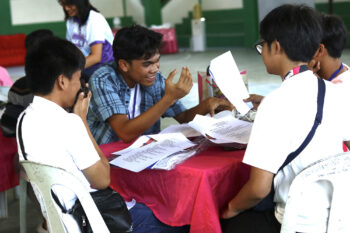CAGAYAN DE ORO CITY (MindaNews / 25 May) – Leaders of Northern Mindanao have collectively expressed “all-out support” for the Bangsamoro Basic Law (BBL), asking Congress “to pass the measure the soonest time.”
In a joint resolution passed by the Regional Peace and Order Council (RPOC) and the Regional Development Council (RDC), the region’s leaders cited that even this early, Northern Mindanao already enjoyed some “gains of the peace process.”
The RPOC and RDC held a joint here Thursday last week. Chief executives of provinces and cities are among the members of both bodies. Apart from local leaders, the RPOC also count as members the heads of security agencies in the region’s provinces and cities, and representatives from civil society.
The RDC, meanwhile, is composed of the same set of local government leaders, heads of regional line agencies, and representatives of the private sector.
“The radical reduction, if not complete absence, of skirmishes between government and Moro Islamic Liberation Front (MILF) forces, has immensely benefited Northern Mindanao through increased business confidence, making it among the most preferred investment destinations in the country,” the RPOC and RDC resolution read.
According to data from the International Monitoring Team (IMT), the third party mechanism overseeing compliance by the government and the MILF of the ceasefire pact, armed encounters between their respective forces have been reduced to the minimum since 2010, indicating the rising confidence between the parties.
From 115 incidents in 2009, the count of skirmishes radically went down to 14 in 2010, and eight by 2011. Between 2012 and 2014, there have been no skirmishes reported by the ceasefire monitors.
The climate of relative peace and security arising from such gain helped fuel economic growth in Northern Mindanao. Between 2010 and 2013, the region’s economy grew 6.2 percent.
This growth performance has helped the region’s trading and industrial hubs Cagayan de Oro and Iligan cities recover from the economic destruction caused by tropical storm “Sendong” in 2011. Both cities are the worst hit localities of the weak but rain-heavy storm.
According to economist Fermin Adriano, the Northern Mindanao and Davao regions stand to immediately benefit from a post-conflict situation in terms of attraction of investments because these areas already have the necessary infrastructure to cater to the needs of various business operations.
The RPOC and RDC members declared that a “resolution of the root causes of the social conflicts breeding rebellions and insurgencies plaguing various parts of the country” makes for “a strong foundation for sustained progress and development.”
“It is our duty as leaders to bequeath a peaceful and progressive society to the next generation hence we must contribute in any way we can to seeing a closure to the Moro rebellion within our lifetimes,” the region’s leaders said.
“The proposed BBL currently pending legislative action in Congress seeks to implement the letter and spirit of the Comprehensive Agreement on the Bangsamoro (CAB), and effectively responds to the Moro people’s longing for self-governance hence address the root cause of the Moro rebellion,” they added.
The Northern Mindanao leaders were hoping the national legislators “pass judgment on the BBL based on social justice.”
The resolution was introduced to the joint meeting by Cagayan de Oro Archbishop Antonio Ledesma who noted that apart from polarizing the people of Mindanao “along ethno-religious identities,” the Moro rebellion has also “led to a dreadful waste of lives, opportunities, economic resources, and personal energies….”
Ledesma narrated that since the 1970s, at least 120,000 people were killed and more than two million people displaced due to war, resulting to low level of human development in conflict-affected communities.
The 2012-2013 Philippine Development Report showed the provinces of Tawi-tawi, Maguindanao and Sulu in the bottom ranks in terms of human development. Lanao del Sur is also included in the list of provinces in the bottom 10.
This, according to Ledesma, amid the huge sums of money spent by government to bankroll the war effort: P73 billion for war materiel from 1970 to 1996; and P20 million per day during the all-out war in 2000, or a total of P1.34 billion.
According to a 2005 World Bank study, an estimated $2 billion to $3 billion was lost in terms of direct output in central and southwestern Mindanao from 1970 to 2001 due to the conflict. If indirect impact is considered, overall economic cost of the conflict could be over $10 billion during 1975–2002.
If the Bangsamoro is institutionalized along with the agreed peace formula, it could contribute to a 0.1 percent gross domestic product (GDP) increase in the near term and up to 0.3 percent in the medium term, according to a study done by the Standard Chartered Bank.
By defining a roadmap to peace, “the political settlement between the government and the MILF, as concretized in the CAB … brings Mindanao in the cusp of historic change,” Ledesma explained. (Ryan D. Rosauro / Contributor)
